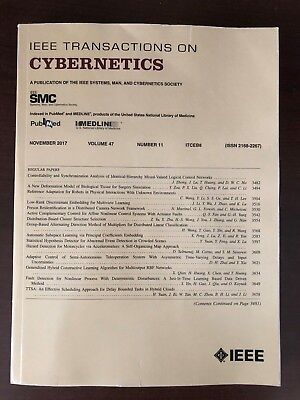Trajectory Tracking Control Employing Nonlinear Compensator and State Observer for Photothermal-Driven Liquid Crystal Elastomer Actuator.
IF 10.5
1区 计算机科学
Q1 AUTOMATION & CONTROL SYSTEMS
引用次数: 0
Abstract
The trajectory tracking control for the photothermal-driven liquid crystal elastomer (LCE) actuator presents a significant challenge due to its hysteresis nonlinear characteristic and its inherent complex deformation mechanism. To address this challenge, this article proposes a trajectory tracking control method for the LCE actuator utilizing a nonlinear compensator and a state observer. The proposed control is a multistep control, which includes temperature control from the input voltage to the LCE temperature and displacement control from the LCE temperature to the LCE displacement. In the proposed method, we design a non-Lipschitz continuous state-feedback controller to realize finite-time convergence control of the temperature. As for the displacement control, we design a state observer to estimate the change rate of the LCE displacement. Meanwhile, a nonlinear inverse compensator is designed to compensate for the hysteresis nonlinearity of the LCE dynamics, which simplifies the complex nonlinear control problem into a linear control problem. Hence, the pole placement method can be utilized to design a trajectory tracking controller to achieve the control objective. The proposed control method is validated by tracking control experiments with different target trajectories.基于非线性补偿和状态观测器的光热驱动液晶弹性体作动器轨迹跟踪控制。
由于光热驱动液晶弹性体(LCE)执行器的滞后非线性特性及其固有的复杂变形机制,对其轨迹跟踪控制提出了重大挑战。为了解决这一挑战,本文提出了一种利用非线性补偿器和状态观测器的LCE执行器的轨迹跟踪控制方法。所提出的控制是一个多步控制,包括从输入电压到LCE温度的温度控制和从LCE温度到LCE位移的位移控制。在该方法中,我们设计了一个非lipschitz连续状态反馈控制器来实现温度的有限时间收敛控制。在位移控制方面,设计了状态观测器来估计LCE位移的变化率。同时,设计了非线性逆补偿器对LCE动力学的滞后非线性进行补偿,将复杂的非线性控制问题简化为线性控制问题。因此,可以利用极点放置法设计轨迹跟踪控制器来实现控制目标。通过不同目标轨迹的跟踪控制实验,验证了所提控制方法的有效性。
本文章由计算机程序翻译,如有差异,请以英文原文为准。
求助全文
约1分钟内获得全文
求助全文
来源期刊

IEEE Transactions on Cybernetics
COMPUTER SCIENCE, ARTIFICIAL INTELLIGENCE-COMPUTER SCIENCE, CYBERNETICS
CiteScore
25.40
自引率
11.00%
发文量
1869
期刊介绍:
The scope of the IEEE Transactions on Cybernetics includes computational approaches to the field of cybernetics. Specifically, the transactions welcomes papers on communication and control across machines or machine, human, and organizations. The scope includes such areas as computational intelligence, computer vision, neural networks, genetic algorithms, machine learning, fuzzy systems, cognitive systems, decision making, and robotics, to the extent that they contribute to the theme of cybernetics or demonstrate an application of cybernetics principles.
 求助内容:
求助内容: 应助结果提醒方式:
应助结果提醒方式:


